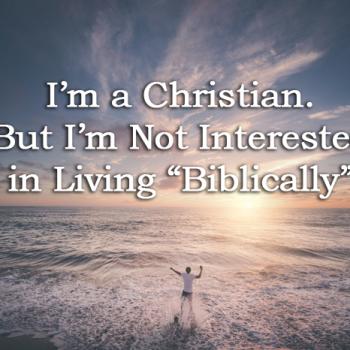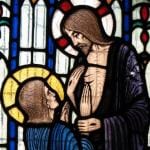True story: nearly loosing my eye 14 years ago taught me how to better read and interpret the Bible.
I was just moving into my condo in Tumon, Guam. I was so excited to move in– it had a beautiful balcony overlooking the Philippine Sea, was just a short walk from the beaches, and I couldn’t wait to get settled. I had been busy moving all day and by now it was later in the evening, so I told myself “just a few more boxes”. In the rush, I made a careless mistake and didn’t see that out of one of the boxes was sticking the metal poles from a rusted out beach chair– and worse, that the plastic cap on the end had fallen off. As I bent down, not seeing it in my peripheral vision, I collapsed to the floor in sheer agony.
I had jammed my eye right into the metal pole.
Sparing you the gruesome details reminiscent of the Christmas Story movie, I quickly found myself in the hospital. The very painful healing process lasted years, having lost 80% of my cornea, and is something that still impacts my life as I live with a painful condition called “reoccurring corneal erosion”. And, though I mostly healed from the ordeal, my eye has never been back to normal. My right eye now has a slight squint to it, and the scarring on my eye acts as a prism which distorts light and often leads to double vision under certain conditions.
However, during a doctor’s appointment one time, I did have an incredible experience that ultimately changed the way I read the Bible. While giving me an eye exam, I was struggling to see the letters correctly out of my right eye. The doctor handed me a tool (no idea what it is called) that had me peer through a small pin hole. To my amazement, when I looked through that pin hole I could read the letters perfectly– the double vision was gone!
Until I took it away from my eye. To this day, the times I see best out of my right eye are the times when I’m looking though a small pin hole.
For me, this experience became a crazy, real-life analogy for reading and understanding the Bible.
Like the light that gets filtered through my eye in a million different directions, there are a lot of things going on in the Bible. Sometimes, there are even conflicting things– such as the violent portraits of God in the Old Testament, compared to the totally nonviolent Jesus of the New Testament. With all these things going on, individual readers are able to walk away with some radically different understandings of what’s going on in the Bible, and radically different understandings of what God is actually like.
Apart from a filter, there’s no hope to ever see what is happening clearly. We all, in one way or another, have obscured vision and an inability to see reality for the way it actually is.
The key to reading, interpreting, and applying the Bible to our lives becomes a matter of reading, interpreting, and applying it through the correct lens: Jesus. Because the truth is,
You’ll never understand the Bible until you understand Jesus.
In the book of John, Jesus claims that he is the object that all of scripture points to– that he is what the story is all about. He also goes on to tell people that if they want to know what God is like, all they need to do is look at him– because “whoever has seen me, has seen the father” (John 14:9). This means he’s not only the object of all of scripture, but that he’s also the only filter through which we can know God or understand the rest of scripture.
The story of the Bible is a story designed to point us to the only filter that can show us what God looks like: Jesus, the nonviolent lover of enemies.
Apart from understanding Jesus, one will never be able to understand the Bible in whole, because such a person will have completely missed the entire point of the Bible.
The point is, Jesus.
Want to know how to read, understand and apply the Bible? The first thing we need to do is read and understand Jesus– because he is the only filter in all of scripture that is the “exact” representation of God (Heb 1:3).
Apart from making Jesus, and only Jesus, the foundation of our faith and practice, and the filter through which we read and understand the rest of scripture, we’re destined to continue to have utterly conflicting ideas of what God is actually like.
God looks exactly like Jesus. The Bible is a book that’s all about Jesus. Which means…
We’ll never understand the Bible until we understand Jesus.
BTW, here was the view and why I was so rushed to unpack:


















